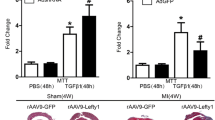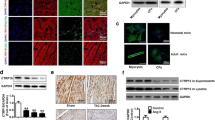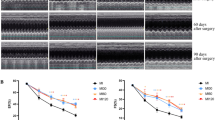Abstract
Expression of the proteoglycan syndecan-1 (Sdc1) is increased in rats with myocardial infarction (MI). This study investigated the effects of Sdc1 overexpression on ventricular remodeling and cardiac function in MI and explored the possible mechanism through in vivo transfection of rats with recombinant adenovirus-carrying rat Sdc1 cDNA. Sprague–Dawley rats (n = 48) underwent intramyocardial injection in the marginal zone of the infarcted area immediately after ligation of the left anterior descending artery. The rats were divided into four groups according to the solution injected: MI Ad-GFP-Sdc1 transfection group, MI Ad-GFP control group, MI saline group, and sham operation group. Cardiac function and collagen expression of each group were examined, and the roles of inflammation, apoptosis, and p38 MAKP signal transduction pathway were investigated. Compared with the rats in the sham operation group, ventricular weight and collagen content increased in MI rats, and cardiac function declined. Substantial inflammatory cell infiltration was seen in the marginal zone of the infarction area, and a great number of myocardial cells were apoptotic. The p38 MAPK signaling pathway was clearly activated. Rats in the MI Ad-GFP-Sdc1 transfection group showed decreased ventricular weight, reduced collagen synthesis, and significant improvement of ventricular remodeling and cardiac function. Post-MI inflammatory cell infiltration and apoptosis was reduced, and the p38 MAPK signaling pathway was inhibited. Overexpression of Sdc1 can improve post-MI ventricular remodeling, and it is possible that the improvement is achieved through reducing apoptosis and suppressing inflammatory response and through the p38 MAPK signal transduction pathway.






Similar content being viewed by others
References
Alexopoulou, A.N., H.A.B. Multhaipt, and J.R. Couchman. 2006. Syndecans in wound healing, inflammation and vascular biology. The International Journal of Biochemistry & Cell Biology 39: 505–528.
Lei, J., S.N. Xue, W. Wu, S.X. Zhou, Y.L. Zhang, G.Y. Yuan, and J.F. Wang. 2012. Increased level of soluble syndecan-1 in serum correlated with cardiac expression in a rat model of myocardial infarction. Molecular and Cellular Biochemistry 359: 177–182.
Vanhoutte, D., M.W. Schellings, M. Götte, M. Swinnen, V. Herias, M.K. Wild, et al. 2007. Increased expression of syndecan-1 protects against cardiac dilatation and dysfunction after myocardial infarction. Circulation 115: 475–482.
Landau, C., M.J. Pirwitz, M.A. Willard, et al. 1995. Adenoviral mediated gene transfer to atherosclerotic arteries after balloon angioplasty. American Heart Journal 129: 1051–1057.
Lei, J., W. Wu, S.N. Xue, and S.X. Zhen. 2009. Establishment and assessment of a rat experimental model of acute myocardial infarction. China Practical Medicine (Chin) 4: 1–3.
Zhang, J., M.X. Xie, X.F. Wang, et al. 2006. Effects of myocardial cell transplantation on the left ventricular remodeling and cardiac function in Wistar rats after myocardial infarction assessed by echocardiography. Chin J Ultrasonography 15(3): 216–219.
Hu, Z.Y., N.F. Luo, and J. Liu. 2009. The protective effects of emulsified isoflurane on myocardial ischemia and reperfusion injury in rats. Canadian Journal of Anaesthesia 56(2): 115–125.
Pieruzzi, F., Z.A. Abassi, and H.R. Keiser. 1995. Expression of renin-angiotensin system components in the heart, kidneys, and lungs of rats with experimental heart failure. Circulation 92: 3105–3112.
Gulati, S.C., D.L. Kacian, and S. Spiegelman. 1974. Conditions for using DNA polymerase I as an RNA-dependent DNA polymerase. Proceedings of the National Academy of Sciences of the United States of America 71: 035–1039.
Zhang, Y.L., S.X. Zhou, J. Lei, G.Y. Yuan, and J.F. Wang. 2008. Blockades of angiotensin and aldosterone reduce osteopontin expression and interstitial fibrosis infiltration in rats with myocardial infarction. Chinese Medical Journal 121: 2192–2196.
Wang, J.B., J. Guan, J. Shen, L. Zhou, Y.J. Zhang, Y.F. Si, et al. 2008. Insulin increases shedding of syndecan-1 in the serum of patients with type 2 diabetes mellitus. Diabetes Research and Clinical Practice 86: 83–88.
Infanger, M., J. Grosse, K. Westphal, et al. 2008. Vascular endothelial growth factor induces extracellular matrix proteins and osteopontin in the umbilical artery. Annals of Vascular Surgery 22: 273–284.
Xu, H., F. Noria, M.J. Sandoval-Cooper, et al. 2009. Severe deficiency of coagulation Factor VII results in spontaneous cardiac fibrosis in mice. The Journal of Pathology 217: 362–371.
Mizoquchi, K., H. Maeta, A. Yamamoto, et al. 2002. Amelioration of myocardial global ischemia/reperfusion injury with volume-regulatory chloride channel inhibitors in vivo. Transplantation 73: 1185–1193.
Rhodes, N.P., C.D. Bartolo, and J.A. Hunt. 2007. Analysis of the cellular infiltration of benzyl-esterified hyaluronan sponges implanted in rats. Biomacromolecules 8: 2733–2738.
Frantz, S., J. Bauersachs, and G. Ertl. 2009. Post-infarct remodelling: Contribution of wound healing and inflammation. Cardiovascular Research 81: 474–481.
Takenaka, H., M. Horiba, H. Ishiguro, et al. 2009. Midkine prevents ventricular remodeling and improves long-term survival after myocardial infarction. American Journal of Physiology. Heart and Circulatory Physiology 296: H462–H469.
Choi, D.S., J.H. Kim, H.S. Ryu, et al. 2007. Syndecan-1, a key regulator of cell viability in endometrial cancer. International Journal of Cancer 121: 741–750.
Abbate, A., F.N. Salloum, E. Vecile, et al. 2008. Anakinra, a recombinant human interleukin-1 receptor antagonist, inhibits apoptosis in experimental acute myocardial infarction. Circulation 117: 2670–2683.
Mann, D.L., and H. Taegtmeyer. 2001. Dynamic regulation of the extracellular matrix after mechanical unloading of the failing human heart: Recovering the missing link in left ventricular remodeling. Circulation 104: 1089–1091.
Ishii, H., T. Amano, T. Matsubara, et al. 2008. Pharmacological intervention for prevention of left ventricular remodeling and improving prognosis in myocardial infarction. Circulation 118: 2710–2718.
Sun, Y. 2009. Myocardial repair/remodelling following infarction: Roles of local factors. Cardiovascular Research 81: 482–490.
Weber, K.T. 1989. Cardiac interstitium in health and disease: The fibrillar collagen network. Journal of the American College of Cardiology 13: 1637–1652.
Zheng, X., T. Zhang, Y. Qin, et al. 1999. Interstitial remodeling of the infarcted area and the non-infarcted area in rats after myocardial infarction. Transact. Second Military Med. Univ. 20: 662–665.
Wei, S., L.T. Chow, I.O. Sham, et al. 1999. Left and right ventricular collagen type I/III ratios and remodeling post-myocardial infarction. Journal of Cardiac Failure 5: 117–126.
Raake, P., G. von Degenfeld, R. Hinkel, et al. 2004. Myocardial gene transfer by selective pressure-regulated retroinfusion of coronary veins: Comparison with surgical and percutaneous intramyocardial gene delivery. Journal of the American College of Cardiology 44: 1124–1129.
Hunter, J.J., and K.R. Chien. 1999. Signal pathways for cardiac hypertrophy and failure. The New England Journal of Medicine 341: 1276–1283.
Yin, H., J. Zhang, H. Lin, et al. 2008. P38 mitogen-activated protein kinase inhibition decreases TNFalpha secretion and protects against left ventricular remodeling in rats with myocardial ischemia. Inflammation 31: 65–73.
Ren, J., S. Zhang, A. Kovacs, et al. 2005. Role of p38alpha MAPK in cardiac apoptosis and remodeling after myocardial infarction. Journal of Molecular and Cellular Cardiology 38: 617–623.
Matsuoto-Ida, M., Y. Takimoto, T. Aoyama, M. Akao, T. Takda, and T. Kita. 2006. Activation of TGF-β1-TAK1-p38 MAPK pathway in spared cardiomyocytes is involved in left ventricular remodeling after myocardial infarction in rats. American Journal of Physiology. Heart and Circulatory Physiology 290: H709–H715.
Jaakkola, P., S. Kontusaari, T. Kauppi, et al. 1998. Wound reepithelialization activates a growth factor-responsive enhancer in migrating keratinocytes. The FASEB Journal 12: 959–969.
Popova, T.G., B. Millis, C. Bradburne, et al. 2006. Acceleration of epithelial cell syndecan-1 shedding by anthrax hemolytic virulence factors. BMC Microbiology 6: 8.
Acknowledgments
This study is funded by the Science and Technology Project Foundation of Guangdong Province (2008B030301333), Medical Science and Technology Research Foundation of Guangdong Province (B2009068) and the Fundamental Research Funds for the Central Universities (12ykpy27).
Author information
Authors and Affiliations
Corresponding author
Rights and permissions
About this article
Cite this article
Lei, J., Xue, S., Wu, W. et al. Sdc1 Overexpression Inhibits the p38 MAPK Pathway and Lessens Fibrotic Ventricular Remodeling in MI Rats. Inflammation 36, 603–615 (2013). https://doi.org/10.1007/s10753-012-9582-y
Published:
Issue Date:
DOI: https://doi.org/10.1007/s10753-012-9582-y




